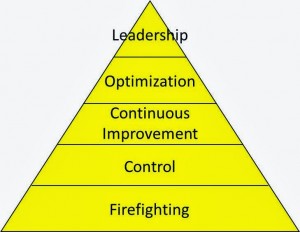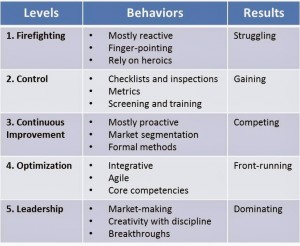Organizational behaviors exist on a continuum. From most chaotic at the base to most disciplined at the apex, the maturity pyramid shows where companies tend to fall. It was conceived by quality guru Philip Crosby1 and later used in various forms by Hewlett-Packard,2 the Baldrige Performance Excellence Program,3 and others. Where does your organization fit?
- Firefighting. The organization is highly reactive, relying on heroics to get things done. Success depends on circumstances, individual strengths, and plenty of luck. Getting sales is the primary focus, and any customer who buys is considered valuable. While the environment may be very creative, there’s typically a lot of stress and finger-pointing, customers are often disappointed, and mistakes are frequently repeated. The company does little to no planning, except possibly annual budgeting, and has limited employee training.
- Control. The organization becomes more aware of processes and takes steps to ensure consistency and repeatability. Checklists, inspection points, and reviews begin to appear, and more often groups coordinate their work. Sales qualification gets better as the company understands some customers are more valuable than others. Some metrics are in place, and annual planning begins to include goals and key initiatives. Execution is spotty, but improving. The company considers employee training important and screens new hires.
- Continuous Improvement. The organization uses formal techniques to systematically improve products, services, and the processes that produce them. Managers and staff are mostly proactive, with the exception of dealing with the occasional hiccup. Metrics are aligned and used extensively, and planning includes a clear vision with short-term and long-term goals. The company successfully executes about half of its planned initiatives. Market segmentation begins to drive development, marketing and sales strategy, and offerings get consistently better. Training is structured and delivered enterprise-wide. Executives carefully construct and manage supply and distribution chains.
- Optimization. The organization’s plans and processes are well aligned and integrated, and potential risks are often identified and resolved in advance. Through a history of continuous improvement and targeted innovation, the company has developed “core competencies” that create competitive advantages and open up entirely new markets. Despite its size, the organization is customer-focused, agile, and routinely introduces successful products and services. Enterprise-wide change initiatives are executed effectively. The company plans and manages human capacity and capability over a multi-year horizon. Cross-functional teamwork is high and organizational learning is methodical and widespread.
- Leadership. A market-maker, the organization uniquely balances the “yin and yang” of creativity and discipline. The company experiments incessantly with breakthrough ideas, carefully evaluating the ones that work, and only then scales up and introduces them. Competitors struggle to keep up. The press lionizes the company’s methods as “best practices.” Despite perennial successes, the company remains on guard against complacency. It quickly detects disruptive shifts in technology, world events, and competitive innovations and mounts strategic responses.
It’s probably no surprise that firefighting produces erratic outcomes. These companies tend to be new, small, or niche players, and they must fight to survive. Organizations with control orientations experience better success rates. Their customers are more often satisfied and buying again, and results are stable and predictable. These companies are “up-and-comers.” Firms doing a good job of continuous improvement are gaining ground, responding to market changes and becoming top competitors in their industries. Studies have shown that over a five-year period, these firms grow revenues and operating incomes twice as fast as those with control or firefighting behaviors.4 Companies optimizing performance are highly regarded and generally maintain top market positions. Examples include Boeing, IBM, Fed-Ex, and Toyota. Finally, a very small number of leading firms dominate their markets for fifteen years or more, producing at least ten times the return on shareholder equity than anyone else in the sector.5 They include Southwest Airlines, Intel, and Progressive Insurance.
Where do you see your organization? Be honest! Chances are you rank your company towards the lower end of the pyramid. That’s where the majority operate.
So what does it take to move up? As it is with individuals, healthy organizational behaviors are the result of good habits, born of discipline. When the right disciplines are combined into an effective strategic management system, excellence soon becomes a matter of habit. Along the way, greater discipline does not suppress creativity, but gives it necessary direction and boundaries. Senior leaders who progressively implement just enough structure at the right time, in the right place, and for the right reasons create beneficial habits and relentless progress.
Sources:
- Crosby, P., 1979. Quality is Free. New York: McGraw-Hill. ISBN 0-07-014512-1.
- Hewlett-Packard Process Consulting services, 1999.
- Baldrige Performance Excellence Program, 2013, 2013–2014 Criteria for Performance Excellence (Gaithersburg, MD: U.S. Department of Commerce, National Institute of Standards and Technology, http://www.nist.gov/baldrige/publications/business_nonprofit_criteria.cfm).
- Hendricks, K. and Singhal, V. March, 2000 “The Impact of Total Quality Management (TQM) on Financial Performance: Evidence from Quality Award Winners” DuPree College of Management, Georgia Institute of Technology
- Collins, J. and Hansen, M. T., 2011. Great by Choice: Uncertainty, Chaos and Luck—Why Some Thrive Despite Them All. Cumulative stock returns, dividends reinvested. Invest $10K on 12/31/1972 and hold until 12/31/2002. © CRSP, Center for Research in Security Prices, Booth School of Business, the University of Chicago.


